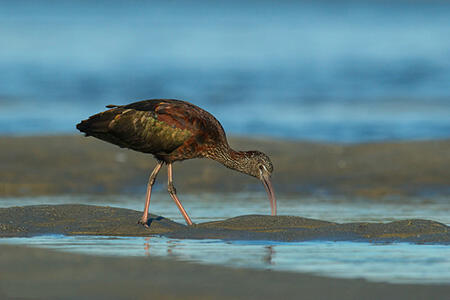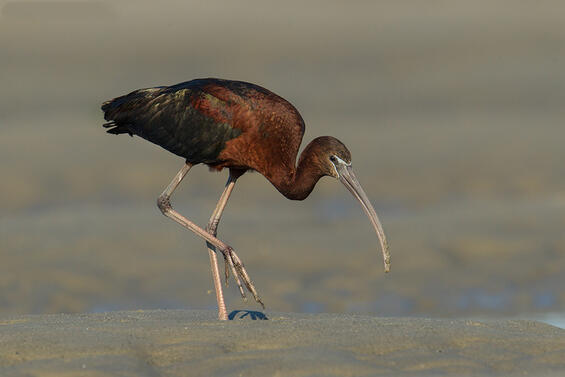- Scientific name: Plegadis falcinellus
Species of Greatest Conservation Need (MA State Wildlife Action Plan)
Description

Glossy ibis (Plegadis falcinellus)
The glossy ibis is a medium-sized wading bird with a dark iridescent plumage, long legs, and a long, decurved bill used to probe substrates for insects and crustaceans. Juvenile glossy ibis are a duller brown color with some white streaking on their neck. When flying, the glossy ibis has its neck stretched forward and legs straight behind it. In addition to consuming animal matter, plants may constitute a major portion of their diet during some seasons. Glossy ibises do not call often but may make murmuring sounds as they forage.
Life cycle and behavior
Glossy ibises use both sight and touch to forage for their omnivorous diet. They will gather into flocks to forage, which can attract other bird species like snowy egrets.
During the breeding season, glossy ibises will court one another by preening and touching bills. Males and females will work together to build a large nest. Nesting in tight colonies, glossy ibis nests are often no more than 61 cm (2 ft) away from each other. The female will lay 3-4 eggs and incubate them for 20-22 days.

Population status
Partners in Flight estimates the global breeding population is 820,000 and the North American Waterbird Conservation Plan estimates 13,000-15,000 breeding glossy ibises to be present on the continent. Over the last several decades, periodic colonial waterbird survey efforts in Massachusetts have revealed a dynamic nesting population of the species with 47 documented nesting pairs in 1994-1995, 144 in 2007-2008, 70 in 2013 and 58 in 2018.
Distribution and abundance
Glossy ibises can be found across the globe. Their range has greatly expanded in the 20th century in North America. This species has gone from a rare and local Florida species to regularly breeding as far north as Maine and occasionally along the east coast of Canada.
The first Massachusetts nests were found at coastal sites in 1974. Although nesting colonies may move among islands in different years, the entire state-wide population is often supported at just a few sites in any given year.

Glossy ibis (Plegadis falcinellus)
Habitat
The glossy ibis is a colonial nesting bird (often with herons and egrets) that builds a nest in shrubs or trees, often on coastal islands. They primarily forage in freshwater marshes, but they are also found in saltwater or brackish marshes, mudflats, ponds, flooded fields, lagoons, and estuaries. Individuals that nest in coastal habitats often forage inland in fresh water. Following breeding, glossy ibis often disperse widely. They are considered semi-nomadic in parts of their range.
Healthy habitats are vital for supporting native wildlife and plants. Explore habitats and learn about conservation and restoration in Massachusetts.
Threats
The major threat to eastern towhee populations in Massachusetts is loss of suitable habitat due to landscape conversion and succession. Though shrubland birds as a group do not appear to be as sensitive to patch-size as other groups of birds, the indirect effects of suburban sprawl can be important through the magnified risks on ground nests from predation (domestic cats, raccoons, jays) and cowbird parasitism.
Conservation
Protection and management of nesting colonies is important for the conservation of the glossy ibis. At some sites, habitat restoration efforts could improve conditions for colony persistence or establishment, especially at sites that formerly hosted colonies but where the habitat is no longer suitable. Identifying and protecting important wintering ground habitat would support the full annual cycle conservation of the species.
References
Davis Jr., W. E. and J. C. Kricher (2020). Glossy Ibis (Plegadis falcinellus), version 1.0. In Birds of the World (S. M. Billerman, Editor). Cornell Lab of Ornithology, Ithaca, NY, USA. https://doi.org/10.2173/bow.gloibi.01
Walsh, J., and W.R. Petersen. 2013. Massachusetts Breeding Bird Atlas 2. Massachusetts Audubon Society and Scott & Nix, Inc.
Contact
| Date published: | May 15, 2025 |
|---|